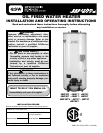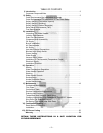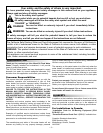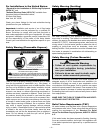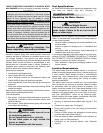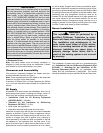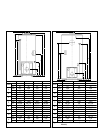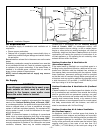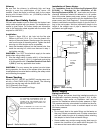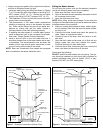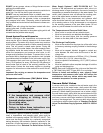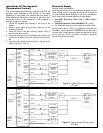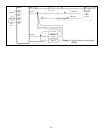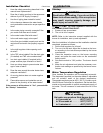
– 6 –
In Earthquake Zones
Note: The water heater must be braced, anchored, or
strapped to avoid moving during an earthquake. Contact
local utilities for code requirements in your area.
Clearances and Accessibility
The minimum clearances between the heater and com-
bustible materials are listed in Figure 1.
Note: These requirements are also listed on the data plate
located on the front of the water heater.
A minimum of 600mm (24 in.) of front clearance and 100mm
(4 in.) on each side should be provided for inspection and
service.
Oil Supply
All aspects of oil tank location and installation, tank size, oil
piping supply and burners, including any fittings, valves, fil-
ters or any fuel handling components must comply with:
• “Installation Code for Oil Burning Equipment
(CAN/CSA-B139)”, (Canada).
• “Standard for the Installation of Oil-Burning
Equipment. (NFPA 31)”, (U.S.A).
• Local codes and regulations.
• Information provided with burner and fuel pump.
Install the oil supply tank with fill and vent lines of adequate
capacity as shown in Figure 4. When an appliance using a
float valve between the supply tank and the burner is con-
nected to a supply tank over 9 gallons (Can.) capacity, a
valve operated by a fusible link shall be installed in the fuel
line adjacent to, and upstream from, the float valve. If any
part of fuel the oil tank is above level of the burner, an anti-
siphon device must be used to prevent flow of oil in case of
an oil line break. Support the oil lines as required by applic-
able codes. Make tank connections with swing joints or cop-
per tubing to prevent breaking in case the tank settles. Make
the swing joints so they will tighten as the tank settles. Non-
hardening pipe joint compounds should be used on all
threads. Do not use Teflon® tape as an oil pipe sealant as it
can cause valves to fail and create hazards. Do not use
compression fittings. Underground piping must be run in a
casing to prevent oil from leaking into the ground or under
the floor. Check local codes for more information.
Burner Installation
The installation of these units shall be in accordance with
the “Installation Code for Oil-Burning Equipment (CSA
B139-04)” or “Standard for the Installation of Oil-
Burning Equipment (NFPA 31)” (as applicable), local
codes and the manufacturer’s instructions. The burner
should be installed only by a qualified Oil-Burner Technician.
IMPORTANT:
This water heater must be installed strictly in accordance
with the instructions enclosed, and local electrical, fuel
and building codes. It is possible that connections to the
water heater, or the water heater itself, may develop
leaks. IT IS THEREFORE IMPERATIVE that the water
heater be installed so that any leakage of the tank or relat-
ed water piping is directed to an adequate drain in such a
manner that it cannot damage the building, furniture, floor
covering, adjacent areas, lower floors of the structure or
other property subject to water damage. This is particular-
ly important if the water heater is installed in a multi-story
building, on finished flooring or carpeted surfaces. GSW
WILL NOT ASSUME ANY LIABILITY for damage caused
by water leaking from the water heater, pressure relief
valve, or related fittings. Select a location as centralized
within the piping system as possible. In any location
selected, it is recommended that a suitable drain pan be
installed under the water heater. This pan must limit the
water level to a MAXIMUM depth of 45mm (1 3/4 in.) and
have a diameter that is a minimum of 50mm (2 in.) greater
than the diameter of the water heater. Suitable piping shall
connect the drain pan to a properly operating floor drain.
When used with a fuel-fired heater, this drain pan must not
restrict combustion air flow.
WARNING
This installation must be performed by a
qualified Oil-Burner Technician in accor-
dance with these instructions and diagrams.
The installation and maintenance of the
water heater must follow all of the instruc-
tions in preceding sections of this manual.
Improper installation can cause injury or
property damage. Heater failure that is a
result of the heating system is not covered
by warranty.



